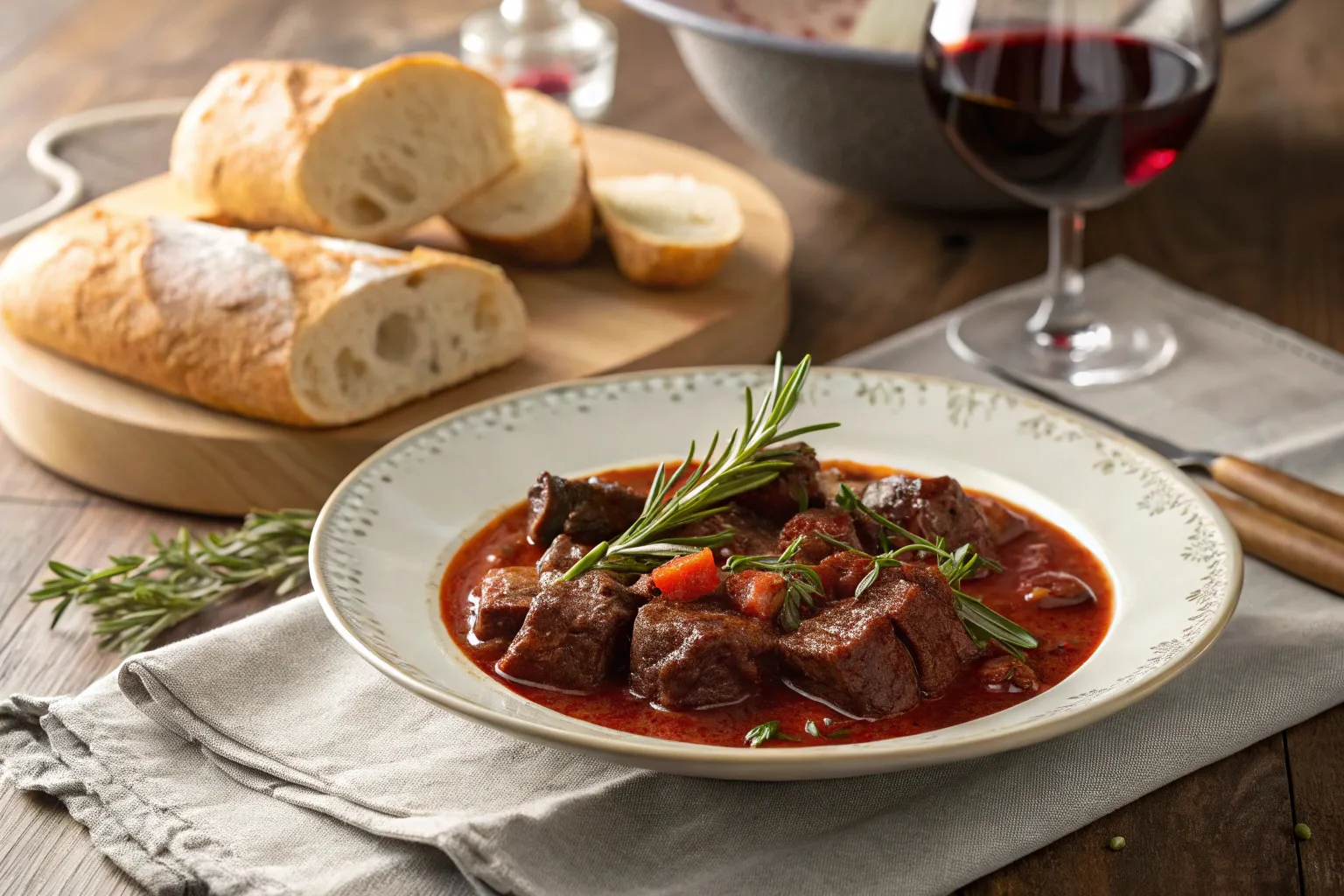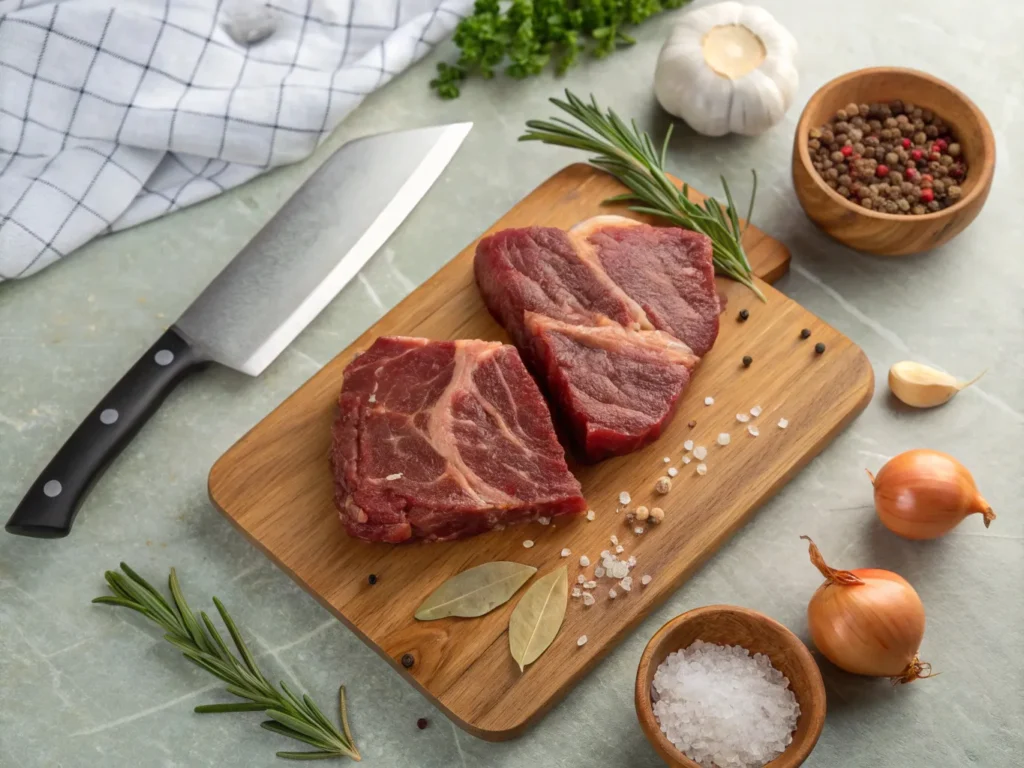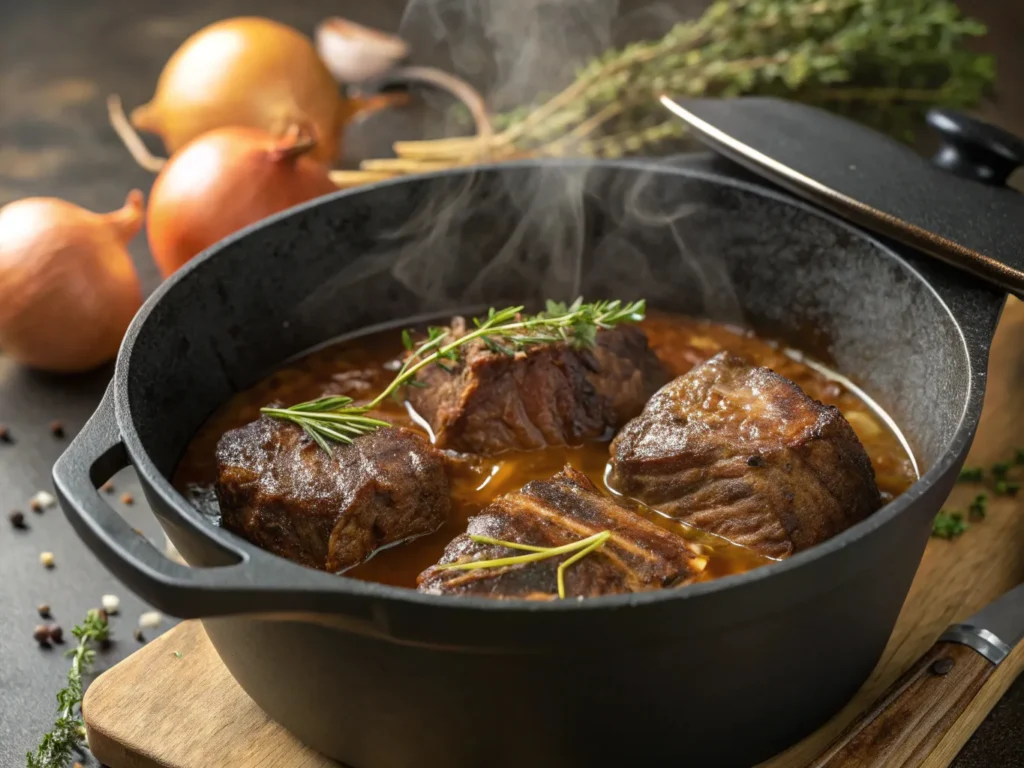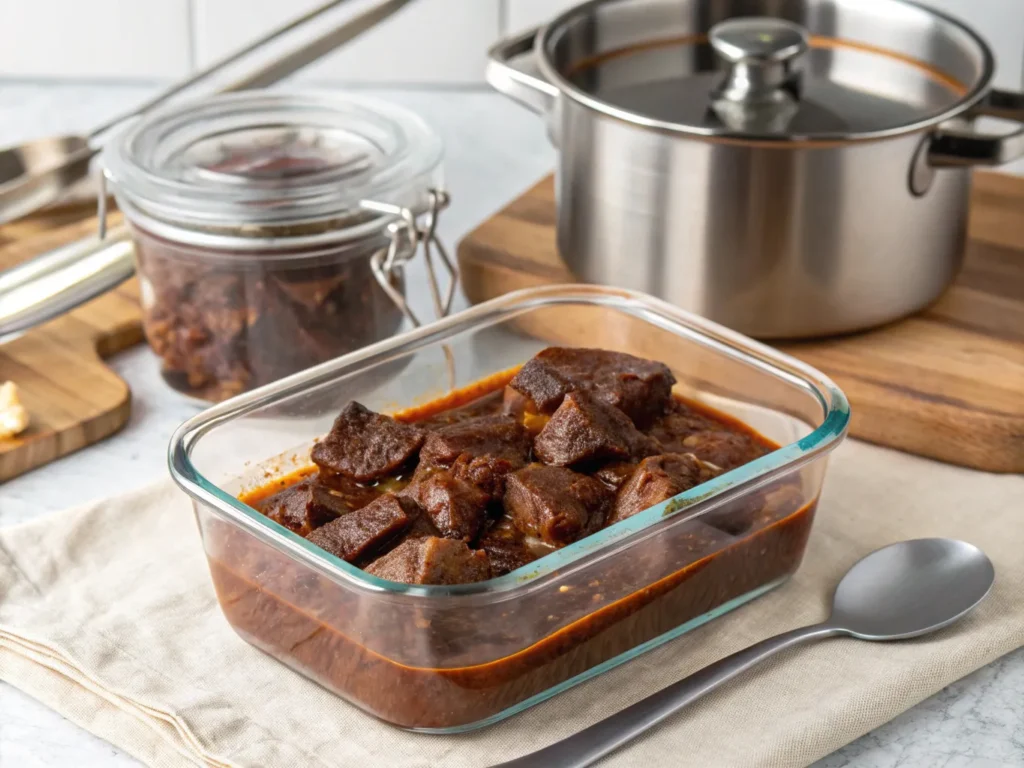
How to Cook Beef Cheek Meat Like a Pro in 5 Steps
Are you ready to discover the incredible potential of beef cheek meat? Often hailed as one of the most underrated cuts of beef, beef cheek meat truly deserves a place in the culinary spotlight. This hidden gem, known for its intensely rich flavor and incredibly tender texture, offers a unique versatility that makes it perfect for a variety of dishes. Sourced directly from the cheek muscles of the cow, beef cheek meat undergoes a remarkable transformation when cooked properly, becoming a melt-in-your-mouth delicacy.
Table of Contents
Step 1: Delving Deep into Beef Cheek Meat
What Exactly is Beef Cheek Meat?
Have you ever wondered about the secrets behind truly flavorful beef? Then, let’s talk about beef cheek meat. This unique cut, sourced from the cheek muscles of cattle, is a hidden treasure among meat lovers. The robust, hardworking nature of these muscles gives beef cheek meat its unparalleled richness and depth of flavor. Packed with connective tissue and collagen, this cut transforms through slow cooking methods, rendering incredibly tender, succulent pieces of meat. Unlike the more widely known ribeye or sirloin, beef cheek meat is set apart by its distinctive texture, and incredibly satisfying, beefy taste. Often hailed by chefs for its amazing ability to both absorb flavors and retain its melt-in-your-mouth texture, when cooked correctly beef cheek meat offers a delightful and unforgettable dining experience.
Why Should You Choose Beef Cheek Meat?
There are many compelling reasons to embrace beef cheek meat. For a start, it is an extremely budget-friendly alternative to some of the more expensive cuts of beef, which makes it perfect for feeding the whole family or for hosting events without exceeding your budget. Despite being an affordable option, the flavor is anything but second rate. Beef cheek meat delivers an amazingly savory and satisfying flavor that can rival even the finest steaks. Furthermore, beef cheek meat offers a wonderful versatility. It is equally at home in rustic comfort meals, such as hearty, slow-cooked stews, or in elevated gourmet meals with a more refined finish. On top of this, the high collagen content of beef cheek meat gives a wonderfully rich mouthfeel and, when slow cooked, contributes to a velvety smooth and rich sauce.
Finding the Best Beef Cheek Meat
When sourcing beef cheek meat it is crucial to choose a high-quality cut to ensure the best results. When shopping, you should prioritize cheeks that are bright red in color, well marbled with fat, and free from any discoloration. Any meat with a grey or overly dry look should be avoided as this is a sign that it may be past its prime. You can always check with your local butcher who is an excellent source for buying fresh beef cheek meat. They can often provide custom cuts based on your requirements as well as providing you with their expert advice.
The Nutritional Value
In addition to being incredibly delicious, beef cheek meat is also incredibly nutritious. It is packed with protein, which is vital for building muscle mass as well as helping repair damage to the body. Also, it is naturally high in collagen which is thought to benefit joint health and improve skin elasticity. Beef cheek meat also includes vital vitamins and minerals, such as iron, zinc, and B12 which are all crucial for overall well-being and energy production. Though it does contain a higher amount of fat than leaner cuts, most of the fat will render down during the slow cooking process, leaving you with deliciously tender and guilt-free results.
Step 2: Expertly Preparing Your Beef Cheek Meat

Trimming: The Essential First Step
Before you start cooking your beef cheek meat, it is vitally important to prepare it correctly to get the best results. The first step to this process is to trim the beef cheek meat to remove any silver skin and excess fat. Silver skin is a tough, shiny membrane, that doesn’t break down during cooking and, if not removed, can negatively affect the texture of your finished dish. You can use a sharp knife, carefully cutting away the silver skin, while being careful to leave the natural marbling of fat intact for added flavor. If you’re a beginner, it can be helpful to place your beef cheek meat on a flat surface, and work slowly and carefully, to ensure you don’t waste any of the wonderfully tender meat. Properly trimming the beef cheek meat in this way will ensure that it cooks evenly and reaches the absolute peak of tenderness.
Marinating Beef Cheek Meat for Maximum Flavor and Tenderness
Marinating your beef cheek meat is an incredibly simple but very effective way to enhance its flavor and overall tenderness. This cut of beef is naturally rich in collagen, and by using an acidic marinade you can help break down the tough fibers, which will ensure you achieve that much sought after melt-in-your-mouth texture. A good basic marinade would be to combine red wine, garlic, thyme, rosemary, and a splash of olive oil. Place your trimmed beef cheek meat into a large resealable bag or a dish, cover with the marinade, and let it sit in the fridge for at least 4 hours – or, ideally, leave it overnight. If you would like a more detailed explanation of how to create the perfect marinade, take a look at this marinade guide for tips on balancing flavors with herbs and spices.
The Essential Tools You Need to Prepare Beef Cheek Meat
Cooking beef cheek meat like a professional requires a few essential tools to get the best result. A slow cooker is the perfect solution for hands-off cooking as this allows the meat to gently simmer over many hours. Another excellent option would be a Dutch oven, which provides an evenly distributed heat for braising. In addition to cooking tools, a sharp chef’s knife is vital for correctly trimming and prepping the meat, while a meat thermometer will ensure the meat is cooked to the perfect temperature. If you are short on time, a pressure cooker will significantly reduce the cooking time, while still delivering an incredibly tender and flavorful result.
Final Prep Before Cooking Beef Cheek Meat
Right before you start cooking your beef cheek meat it is important to pat it dry with paper towels. This step will allow the meat to sear properly which is needed to create a golden-brown crust that locks in flavor. Then, season your beef cheek meat generously with salt and pepper, or whatever your favorite spice blend is, to add additional depth of flavor to the finished dish. If you are planning to braise the beef cheek meat, you will need to preheat your cooking pot and add a little oil to prevent any sticking. Searing each side of your beef cheek meat will not only add more flavor but also provide a rich base for your cooking liquid.
Step 3: Mastering the Art of Cooking Beef Cheek Meat
Braising: The Ultimate Method for Beef Cheek Meat

When it comes to truly transforming beef cheek meat into a wonderfully tender and flavorful dish, braising is widely considered to be the gold standard. This technique requires you to first sear your beef cheek meat, and then slowly cook it in a delicious liquid, at a low temperature. The end result is a dish that is incredibly rich in flavor, with pieces of meat that practically melt in your mouth. Start by heating a heavy bottomed pot or a Dutch oven over a medium-high heat. Add a splash of oil to the pot, then sear the beef cheek meat on all sides until it is golden brown. Once you have achieved a good sear, deglaze the pot with red wine or beef stock, making sure you scrape up all of the caramelized bits at the bottom to really enhance the flavor. Add your aromatic ingredients, such as onions, garlic, and fresh herbs, then cover the pot with a lid and let the beef cheek meat gently simmer for 3-4 hours. For a detailed guide on braising techniques, check out our related article: Cowboy Casserole Recipe.
Slow Cooking: A Hands-Off Approach to Unmatched Tenderness in Beef Cheek Meat
If you prefer a method that requires less hands-on work, then slow cooking your beef cheek meat is an excellent choice. The consistent low heat in a slow cooker ensures that the connective tissues will break down completely. This means that you will achieve wonderfully fork-tender meat with minimum effort. To prepare using this method, simply add your seasoned beef cheek meat, along with vegetables, and your choice of liquid, such as beef broth or a tomato-based sauce to the slow cooker. Set your slow cooker to a low heat, and then let it work its magic for 6-8 hours. For busy people who want a gourmet quality meal, this method allows you to prepare something fantastic while you get on with other tasks.
Pressure Cooking: Achieving Perfect Results with Beef Cheek Meat in Less Time
If you are short on time, but still want to achieve the tenderness that beef cheek meat is famous for, then pressure cooking is a perfect option. Using a pressure cooker can reduce the overall cooking time to just 1-1.5 hours, which makes it a good method for a weeknight dinner. To cook using this method, you first sear the beef cheek meat in the pressure cooker using the saute mode. Then add your liquid and aromatics. Seal the lid, and cook at high pressure, making sure that the steam builds up fully before you start the timer. Once the cooking is finished, let the pressure release naturally, for the best results.
Sous Vide: Precision Cooking for Beef Cheek Meat
Sous vide cooking is a popular method that is often favored by gourmet chefs. With this method, you can achieve perfectly cooked beef cheek meat, every time. By immersing the meat in a water bath that is carefully controlled to a certain temperature, over an extended period, you can ensure that it is evenly cooked, and retains all of its delicious juices. For the best sous vide preparation of beef cheek meat, season the meat and vacuum seal it, then set the water bath to 185°F (85°C). Allow the meat to cook for 12-16 hours. Finally, sear the cheeks in a hot pan, to develop a beautiful caramelized crust before serving.
Step 4: Serving Your Perfectly Cooked Beef Cheek Meat
Creative Serving Ideas for Beef Cheek Meat
One of the greatest things about beef cheek meat is how incredibly versatile it is, and how wonderfully it can be paired with a vast range of different dishes, from rustic, to gourmet. For a classic approach, serve your beef cheek meat as part of a hearty, and comforting stew, with potatoes, carrots, and a rich, thick savory sauce. This traditional preparation perfectly highlights the wonderfully rich, melt-in-your-mouth texture of the meat. Or, if you prefer, use your beef cheek meat as a key component of some more creative dishes, such as tacos. Simply shred the wonderfully tender meat, and serve it in warm tortillas, with a range of fresh toppings like cilantro, diced onions and a squeeze of lime for a truly bold, flavorful twist. If you are going for a gourmet style, plate the beef cheek meat on top of some creamy polenta, or buttery mashed potatoes, and drizzle over the cooking juices.
Tips for Plating and Garnishing Beef Cheek Meat
Even dishes that are incredibly delicious, will benefit from a thoughtful and appealing presentation. For rustic dishes, serve the beef cheek meat in a deep bowl, letting all of the delicious sauce pool around the meat, creating a wonderfully inviting and hearty look. Garnish with a sprig of fresh rosemary or thyme, to further enhance the wonderful aroma of the dish. If you are plating a meal with a more refined approach, consider carefully slicing the beef cheek meat and arranging the pieces over a bed of vegetables, or grains. Use a drizzle of reduced sauce to give a perfectly polished finish, and add a sprinkle of finely chopped parsley for a burst of vibrant color. These small touches really help to elevate the dish, and make it incredibly visually appealing.
Pairing Suggestions for Beef Cheek Meat
Pairing your beef cheek meat with the correct sides and drinks will greatly enhance the overall dining experience. If you are serving a stew, crusty bread, or a side of roasted vegetables, will work perfectly and offer a wonderful contrast of textures and flavors. Creamy polenta, or risotto, will be a fantastic compliment to the richness of the meat if you are serving a more gourmet style dish. When choosing a drink to serve with your beef cheek meat consider a bold red wine, such as Cabernet Sauvignon or Syrah, as this will pair wonderfully with the deep flavor of the meat. If you are looking for a non-alcoholic option, a rich grape juice, or sparkling water infused with herbs, can offer a wonderfully refreshing touch.
Serving Beef Cheek Meat for Special Occasions
Because it feels indulgent but yet so approachable, beef cheek meat is a fantastic choice for special gatherings and holidays. Serve it as the main course for a dinner party, pairing it with some elegant sides such as truffle mashed potatoes or roasted asparagus. If you want a more casual approach, you could serve beef cheek sliders which are both fun, and packed with flavor. Simply shred the cooked meat, and pile it onto small buns, adding a little dollop of coleslaw for added crunch. Whether your approach is rustic or gourmet, beef cheek meat is sure to bring a touch of sophistication to any meal.
Step 5: Expert Tips, Troubleshooting and Common Mistakes
Common Mistakes to Avoid When Cooking Beef Cheek Meat
Although cooking beef cheek meat can be an incredibly rewarding experience, there are several common mistakes that you should be aware of, as they can negatively affect your results. One very frequent mistake is cooking at a high heat throughout the entire cooking process. Although using a high heat might seem like a good way to save time, it can actually toughen the beef cheek meat rather than breaking down the collagen. So, to ensure that your beef cheek meat becomes wonderfully tender, it is best to always opt for a low and slow method of cooking. Another mistake that people often make is skipping the all important searing step. Searing the beef cheek meat locks in all of the delicious juices, and adds a wonderfully caramelized flavor, which really helps to elevate the overall dish. Even if you are using a slow cooker for your method of cooking, taking the time to sear the beef cheek meat beforehand, will make a noticeable and positive difference. Finally, a common error is to avoid under-seasoning your beef cheek meat. Because this cut is so rich and full of flavor, it actually pairs incredibly well with bold seasonings. So, don’t be afraid to experiment with different herbs and spices to create a dynamic and delicious tasting experience.
Time Saving Hacks When Cooking Beef Cheek Meat
Cooking beef cheek meat can be a fairly time-consuming process, however, there are a number of ways that you can save some time, without sacrificing any quality. For example, if you are short on time you can always trim and marinate your beef cheek meat the night before you want to cook it. Not only will this save time on the day of cooking, but it will also allow the flavors to fully penetrate the meat. Another time saving tip, would be to use a pressure cooker. As discussed earlier, this method will greatly reduce the cooking time, while still allowing you to achieve a tender and flavorful result. If you are hosting a gathering, it is also a good tip to cook the beef cheek meat in advance, and then simply reheat it in its sauce when you are ready to serve, which will really help save time on last-minute preparations.
Tips for Storage and Reheating Beef Cheek Meat

If you have any left-over beef cheek meat, it is important that you store and reheat it correctly, to ensure that it is just as delicious as when it was first served. You should always store cooked beef cheek meat in an airtight container, and be sure to store it with its sauce, to help keep it wonderfully moist. If stored correctly in the fridge, left-overs can last up to 3 days, and if you are freezing it you can store it for up to 3 months. When reheating your beef cheek meat, the best method to use is a stovetop. Simply place the meat and the sauce into a covered pan, and heat gently on a low setting, remembering to stir it occasionally, to prevent it from sticking. If possible, you should avoid reheating in the microwave as this can dry out the meat and negatively affect the texture. Gently reheating the meat on the stovetop, will help to preserve the wonderfully tender texture.
Pro Tips to Elevate Your Beef Cheek Meat Dish
For the very best results when cooking beef cheek meat, be sure to use a good quality stock, or wine, as your cooking liquid. The flavors will really concentrate as the beef cheek meat cooks, so using a robust base will ensure you achieve a more delicious final dish. Also, be sure to never discard the liquid once the meat is cooked as it makes an incredible sauce! Simply strain the liquid, reduce it on the stovetop, and then whisk in a small pat of butter, to give you a silky smooth finish. Finally, remember to always rest your beef cheek meat for a few minutes after cooking, as this allows the juices to redistribute through the meat, and ensures that every bite will be as flavorful as it possibly can be.
FAQs
What is beef cheek meat?
Beef cheek meat is a flavorful cut of beef sourced from the cheek muscles of cattle. This cut is known for its high collagen content, which makes it tough when raw but incredibly tender and juicy when cooked slowly. Its rich, meaty flavor makes it a favorite in recipes like braises, stews, and tacos. With proper preparation and slow-cooking techniques, beef cheek meat transforms into a melt-in-your-mouth delicacy that’s perfect for hearty, satisfying meals.
Why is beef cheek so expensive?
Although not as costly as premium cuts like tenderloin or ribeye, beef cheek meat can be relatively expensive due to its limited supply. Each cow only provides a small amount of cheek meat, making it less available compared to larger cuts. Additionally, its popularity among chefs and food enthusiasts for its unique flavor and texture increases demand, contributing to its price. However, its versatility and ability to create gourmet-level dishes often justify the cost.
Is beef cheek meat tough?
Raw beef cheek meat is naturally tough because it comes from a hardworking muscle. However, when cooked using slow, moist-heat methods like braising or slow cooking, its high collagen content breaks down, resulting in an incredibly tender and luscious texture. This transformation makes it ideal for dishes that require long cooking times, such as stews or shredded beef recipes. With the right technique, you’ll achieve a dish that’s far from tough—it’ll be perfectly tender.
Is beef cheek a good cut?
Yes, beef cheek meat is an excellent cut of beef, especially for those who appreciate rich, bold flavors and tender textures. While it requires more preparation and longer cooking times than some other cuts, the payoff is well worth the effort. It’s also highly versatile, lending itself to a wide range of dishes, from rustic stews to gourmet plates. If you’re looking for a cut that’s both affordable and capable of delivering a memorable dining experience, beef cheek meat is a fantastic choice.
Conclusion
Cooking beef cheek meat like a true professional is definitely much easier than you might initially think, and the final results are undeniably worth the small effort that is required. From gaining a full understanding of what makes this incredibly delicious cut so very special, to mastering the various preparation techniques, cooking methods, and all the best serving ideas, you now have all the necessary tools and information you could possibly need to create wonderfully mouthwatering dishes that are sure to impress every single time you cook them. Whether you choose to use the braising method, a slow cooker, or a pressure cooker, the beef cheek meat will reward your patience with unmatched tenderness, and a flavor that is truly unforgettable. Its incredible versatility means that you can enjoy it in many different ways, from hearty comforting stews, to incredibly flavorful tacos, or even as a key component in stunningly beautiful gourmet meals that taste just as good as they look.
